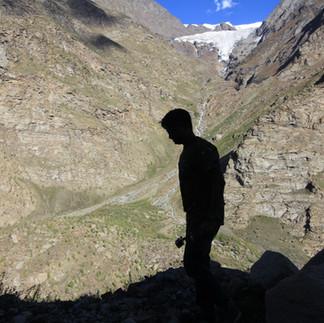Discovery of the Unknown Lakes: Stand-Up Paddle Boarding in the Lakes of Chennai – The Beginning
- Kumaran Geopaddler

- Sep 5
- 5 min read
Updated: Sep 6
I have been mulling over writing this for quite some time now, making elaborate plans on how to present the story, how to illustrate it, so on and so forth, and thus putting it off entirely. However, the minute I started writing it, all excuses vanished, and I did not get up from my chair for six hours straight.
Home
Chennai is my home. It is where I went to school, went out with friends, shopping, to the beach, to movies, and later to restaurants, malls, and to the beach – well, that is forever. It is the city that grew up along with me, and now, it grows up along with my son. As we grow, parts of us change, and so does the city. Well, not all change is progress. Once I learnt Stand-Up Paddling, I started exploring the lakes of Chennai. This was nearly a decade ago, and today, parts of whatever I saw do not exist anymore. I wish I could tell you that I did not predict it, but I did. While I thought this change would happen eventually, I did not expect it to happen within ten years. I understand; urbanization, increase in GDP, and development on the one hand, but at what cost?


Time was of the essence. Ironic, as in geology, slow progression of natural events was basically what we are used to. Nature is supposed to slow us down. This sudden change shook something alive within me. Most of these lakes are virtually unknown to the general populace, and what if they are made to disappear without a trace? What if a decade later, a person sees a map of a lake right next to where they were, but there was no lake? I decided to do what I could at the time, take the lakes seriously.

The Shift
In 2014, I started Stand-Up paddling at Kovalam, and in the span of one year, I could see changes happening in the landscape of Kovalam itself. After the 2015 floods, from Bay of Life, we provided rescue and support to the nooks and crannies of the flood-affected areas within our reach, using kayaks and paddleboards, in some places even before the NDRF. The events of the year changed me.
As a 35 year old geologist comfortably working for a corporate company, with more leaves than I could ask for, I had everything I wanted. Although not a professional sportsperson, I was quite fit physically and had the discipline to see things through. Also, I was a single father to my son, and my mother was raising him back home as I was working away from home. I was exploring the Western Ghats, Himalayas, started Stand-Up Paddling, created many records, got quite a bit of recognition, but was lacking something – my Ikigai.
The years 2014 to 2015 were tumultuous at work as well; there was a huge recession going on in the Oil and gas industry where I was working. The otherwise stable industry was rocking, forcing me to rethink my next steps. Although I was not in the immediate crossfire, it was only a matter of time, so I had to cover my back. I wanted to expand upon Stand-Up paddling, but I didn’t know how to. I considered conducting SUP classes, but unlike surfing, SUP needs a vast body of water.
The 2015 floods showed us the mirror of what an ecological disaster we were. At Kovalam, I saw tons and tons of pollutants going via Muttukadu backwaters to the sea. We did go on an expedition but had to pull out. SUP expeditions had to be ruled out there, for now. I needed to find other water bodies, like my tomorrow depended on it. Fortunately I had the strong support of my family, who understood that there was a method to what could definitely be perceived as madness in my pursuit of Stand-Up Paddling.
The Flux
After the floods, a couple of friends and I started our exploration in Madurantakam lakes, and on the way to Palar, we came across amazingly beautiful lakes. That’s when we came across Lake LAT 1240. It was a slice of heaven in the city – a hillock 100 meters to the East, the golden sunset in the west, no one around us, the sounds of the water flowing past us, and most importantly, a 90 minute drive from home. I christened it LAT 12 40, going by its geographical coordinates, mainly as I did not want to publicize an unknown lake lest it gets trashed. However, I had to temporarily put a pin on it and tend to other matters.
At Bay of Life, we had a program on the next Valentine’s Day that involved SUP sessions at the sea. As the day went by, I assisted a couple on a board, when one of them toppled in the zone of the wave break. It was a near-miss incident, and was quite scary. That incident made me come to peace with my limitations – I cannot do SUP training on a large scale, I absolutely need to adopt a one-on-one approach. Which meant, the location mattered. The waters needed to be flat, shallow enough to feel safe but not too shallow that the board gets stuck, the lake needs to be scenic, and the location needs to be accessible.
Around 2015, the culture of outdoor exploration increased in India, and many people started travelling and exploring Nature, which was a good thing overall. It would soon become a headache in itself when many people without any prior knowledge of exploration and safety go on an adventure, endangering both themselves and Nature, and exploiting it by defacing, littering, and destroying it for personal gains. I was clear that I wanted any event I would conduct to be incident-free. Nature is for all, no one is her gatekeeper, but one can for sure be the bouncer.

The Quest
I would spend hours poring over Google maps, actively searching for hints of dark greens in the almost-brown neighbourhood. The suburb of South Chennai is one of the largest wetlands of Tamilnadu, and as a geologist and a history lover, I was piqued. Once I zeroed on a lake, I would load the paddleboard on my car and go there, mostly with my mother and my son, who was a kid back then, sometimes with friends, sometimes alone. I would document the lake, check for its suitability for Stand-Up Paddling, and then set up SUP sessions. Over time, I gave a lot of content to newspapers, television interviews, seminars, and classes. I started conducting expeditions in all lakes, expanding from the smallest lake in Chennai to the highest point in the Himalayas, from the rapids of Ganges to the fjords of Norway. I don’t even reside at Chennai; stationed at Gurgaon then and Kuwait now, but my heart calls it home, and bleeds as each lake shrinks.
Like the ancient explorers who explored the waters in search of land, I went on land searching for water. In January 2016, I locked in on an area and took my mom and Shakthi to explore. We went to the Maragadha Lingam temple at Tiruvadisoolam, built by the Cholas. It was on a beautiful hillock at 100 meters elevation, in a range of small hillocks. The chill Margazhi air gave the place an added beauty. The place was a typical laidback rural village with people catching fish, crabs, and prawns for their livelihood. Having lived in Chennai all my life, it was my first time seeing such an undisturbed agricultural community so close to the city. The map showed patches of forest, and a sign board warned us of leopards. At the temple, I marveled at the Chola architecture, town planning, irrigation, and revenue systems. And then we came to the lake. Periyaputheri Lake. Stretching up to 2 to 3 kilometers in length, it was large and calm like the sea, and at that time, it was only the three of us there. It was just perfect.
I finally found my Ikigai.






















































Comments